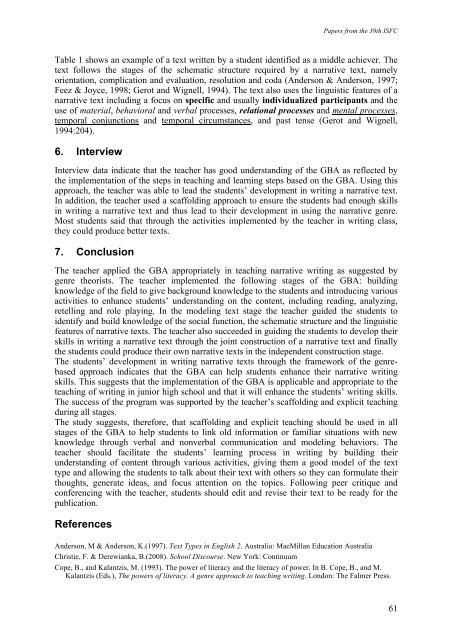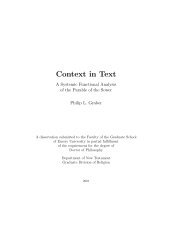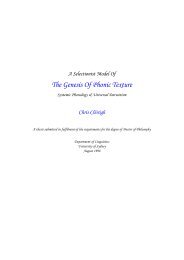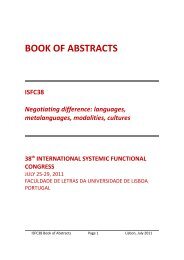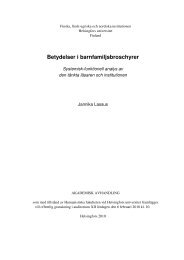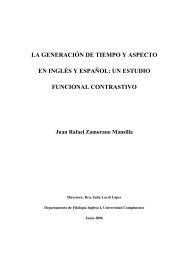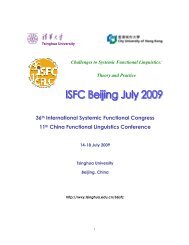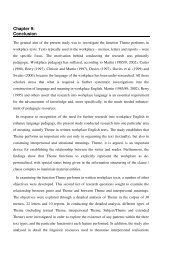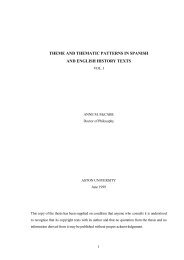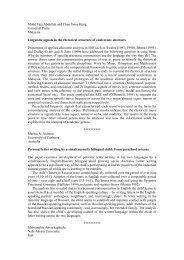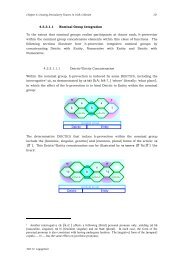the ISFC39 Proceedings - International Systemic-Functional ...
the ISFC39 Proceedings - International Systemic-Functional ...
the ISFC39 Proceedings - International Systemic-Functional ...
You also want an ePaper? Increase the reach of your titles
YUMPU automatically turns print PDFs into web optimized ePapers that Google loves.
Papers from <strong>the</strong> 39th ISFCTable 1 shows an example of a text written by a student identified as a middle achiever. Thetext follows <strong>the</strong> stages of <strong>the</strong> schematic structure required by a narrative text, namelyorientation, complication and evaluation, resolution and coda (Anderson & Anderson, 1997;Feez & Joyce, 1998; Gerot and Wignell, 1994). The text also uses <strong>the</strong> linguistic features of anarrative text including a focus on specific and usually individualized participants and <strong>the</strong>use of material, behavioral and verbal processes, relational processes and mental processes,temporal conjunctions and temporal circumstances, and past tense (Gerot and Wignell,1994:204).6. InterviewInterview data indicate that <strong>the</strong> teacher has good understanding of <strong>the</strong> GBA as reflected by<strong>the</strong> implementation of <strong>the</strong> steps in teaching and learning steps based on <strong>the</strong> GBA. Using thisapproach, <strong>the</strong> teacher was able to lead <strong>the</strong> students’ development in writing a narrative text.In addition, <strong>the</strong> teacher used a scaffolding approach to ensure <strong>the</strong> students had enough skillsin writing a narrative text and thus lead to <strong>the</strong>ir development in using <strong>the</strong> narrative genre.Most students said that through <strong>the</strong> activities implemented by <strong>the</strong> teacher in writing class,<strong>the</strong>y could produce better texts.7. ConclusionThe teacher applied <strong>the</strong> GBA appropriately in teaching narrative writing as suggested bygenre <strong>the</strong>orists. The teacher implemented <strong>the</strong> following stages of <strong>the</strong> GBA: buildingknowledge of <strong>the</strong> field to give background knowledge to <strong>the</strong> students and introducing variousactivities to enhance students’ understanding on <strong>the</strong> content, including reading, analyzing,retelling and role playing. In <strong>the</strong> modeling text stage <strong>the</strong> teacher guided <strong>the</strong> students toidentify and build knowledge of <strong>the</strong> social function, <strong>the</strong> schematic structure and <strong>the</strong> linguisticfeatures of narrative texts. The teacher also succeeded in guiding <strong>the</strong> students to develop <strong>the</strong>irskills in writing a narrative text through <strong>the</strong> joint construction of a narrative text and finally<strong>the</strong> students could produce <strong>the</strong>ir own narrative texts in <strong>the</strong> independent construction stage.The students’ development in writing narrative texts through <strong>the</strong> framework of <strong>the</strong> genrebasedapproach indicates that <strong>the</strong> GBA can help students enhance <strong>the</strong>ir narrative writingskills. This suggests that <strong>the</strong> implementation of <strong>the</strong> GBA is applicable and appropriate to <strong>the</strong>teaching of writing in junior high school and that it will enhance <strong>the</strong> students’ writing skills.The success of <strong>the</strong> program was supported by <strong>the</strong> teacher’s scaffolding and explicit teachingduring all stages.The study suggests, <strong>the</strong>refore, that scaffolding and explicit teaching should be used in allstages of <strong>the</strong> GBA to help students to link old information or familiar situations with newknowledge through verbal and nonverbal communication and modeling behaviors. Theteacher should facilitate <strong>the</strong> students’ learning process in writing by building <strong>the</strong>irunderstanding of content through various activities, giving <strong>the</strong>m a good model of <strong>the</strong> texttype and allowing <strong>the</strong> students to talk about <strong>the</strong>ir text with o<strong>the</strong>rs so <strong>the</strong>y can formulate <strong>the</strong>irthoughts, generate ideas, and focus attention on <strong>the</strong> topics. Following peer critique andconferencing with <strong>the</strong> teacher, students should edit and revise <strong>the</strong>ir text to be ready for <strong>the</strong>publication.ReferencesAnderson, M & Anderson, K.(1997). Text Types in English 2. Australia: MacMillan Education AustraliaChristie, F. & Derewianka, B.(2008). School Discourse. New York: ContinuumCope, B., and Kalantzis, M. (1993). The power of literacy and <strong>the</strong> literacy of power. In B. Cope, B., and M.Kalantzis (Eds.), The powers of literacy. A genre approach to teaching writing. London: The Falmer Press.61


